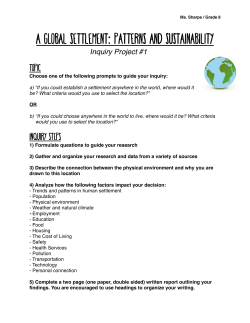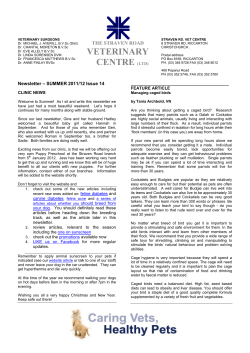
HSN Grant Story Tiny Kittens copy
Healthy Schools Network Story Template Date: March 24, 2015 School Name: Holly Elementary School District: 37 Contact Names: Lynda Tyler, Classroom Teacher & Vikki Chapman, Principal Figure 1 Tiny Kittens Leaders Lynda Tyler & Shelly Roche Contact Email/Phone Number: vchapman@deltasd.bc.ca ltyler@deltasd.bc.ca Did you receive an Activity Grant or an Inquiry Grant? Yes PART 1: Tell us about the learners at your school. (Gathering Evidence/Scanning) (E.g. what did you notice about the experience of your learners that was most important to your work? Are you a rural, urban or new school?) The Tiny Kittens experience was irresistibly engaging, enhanced through technology, and steeped in real-life problem solving. Students joined a collective effort because they shared a passion and purpose, which made learning intrinsically motivating. Engaging in meaningful dialogue and working cooperatively on assignments such as writing, illustrating, public speaking, and acting enabled students to understand, appreciate and express their views at a deeper level. The experience also helped them become reflective, independent learners. http://web.deltasd.bc.ca/news/407 The students developed insight into what they as individuals can do and were eager to have their voices heard and lead different activities. The students’ personal dispositions, filtered and framed by their life experiences, values and beliefs, expanded and shifted, increasing student voice with the context in which they were embedded. It was interesting to watch the students discuss, negotiate and create in respectful ways. Some students, who normally do not stand out, took on leadership roles. Importance was attached to the emergence of civic efficacy, or a belief that one can make real and lasting change in their social world. Consequently, it was not just a handful of students that emerged as leaders, but ¾ of them became leaders. PART 2: What did you do? (Focus and Plan, New Learning) 1 *This template is adapted from the Spiral of Inquiry (www.noii.ca) (What keys areas of health and learning did you focus on? What were your driving questions? What contributed to the need to address health and learning at your school? What did you do to make things better? What tools/resources did you use?) What contributed to the need to address health and learning at your school? What contributed to the need to address health and learning at your school? My main interest was in building a community within the classroom – a place where students would feel safe, happy, excited and willing to take risks. This project started out as a curiosity and became larger as we progressed (primarily because of the encouragement from Shelly Roche of TinyKittens.com and the students enthusiasm and engagement). There is a lot of research on the benefits of Human-Animal Interaction. I was curious to see how Tiny Kittens would impact my students on a social-emotional level. What keys areas of health and learning did you focus on? 1. Healthy relationships – building a community within the classroom based on research related to the benefits of social-emotional learning 2. Human-Animal Interaction – social-emotional level; ethical conduct, ethical citizenship (raise awareness with public advocacy, adoption, and responsible pet ownership) 3. Technology – social media Shelly Roche’s Facebook Livestream experience and ipads, specifically Book Creator and Padlet What were your driving questions? How can Tiny Kittens further our social and emotional health? How can social media tools support and improve student engagement? What did you do to make things better? What tools/resources did you use? The invitational nature of the learning environment and technology established new kinds of learning, communication and interaction. Students were able to learn a tremendous amount about the influence/impact of social media through Shelly Roche’s Facebook posts and their Livestream experience. Ipads, specifically Book Creator and Padlet were also used to enrich the existing learning experience. Sharing the project digitally situated learning in a context where outcomes were brought to life with real world connections, stories and relevance. Posting information online led to reciprocal communication and demonstrated to the students that others valued their ideas and opinions. The positive and affirming response of the stories and overwhelming responses from Shelly Roche and extended audience of those who have posted comments is validation of how children can made a difference in the community and in the lives of shelter animals, especially cats. https://www.facebook.com/tinykittens/photos/pb.462536430487893.2207520000.1427835570./755325297875670/?type=3&theater Collaboration, sharing of ideas and building of knowledge were not limited to the classroom. Parents, other students, teachers, and the Principal, for example, accessed the project providing 2 *This template is adapted from the Spiral of Inquiry (www.noii.ca) and opportunity for collaborative knowledge building. Effective relationships that fostered students’ communication skills: one-on-one, in peer groups, in digital communities, resulted in increased student collaboration, and engagement in writing. Nurturing students to connect with the world around them through social media and in locally at the shelter, created an authentic passion for learning and developed student voice. PART 3: How did it go? (Taking Action) (E.g. what actions or strategies did you decide on? Who was involved? What type of support did you gather? How were students involved? What new areas of professional learning did you explore? What difference did this make for students and the school community? How did this impact students’ learning?) What actions or strategies did you decide on? The experience was rooted in a participatory world-view, where students move towards forms of knowing that are deeply engaged and include student voice. Interactive experiences engaged the students to share with others, and inspired them to take further action. The teacher’s role was as facilitator: to explore problems, suggest alternate perspectives, and facilitate the students’ active participation as leaders in a student-centred learning environment. Community-based learning and outside-the-classroom experiences were linked to selfdevelopment in building connections. The students felt very connected to Shelly Roche of TinyKittens.com. Not only were they writing and creating for her, but they knew there was a strong possibility her Facebook and Livesteam audiences would see their work, as well. Bonding – The students felt very protective of the kittens and took the responsibility of meeting them and being Live streamed very seriously, as they knew the “world” was watching and judging them based on their behaviour.. The students were inspired and excited to embrace a high standard of care and protection for shelter cats. While the students continue to learn more about Dorothy and the kittens, they also learn about themselves by considering the kitten's emotions and feelings, which in turn, helps them develop the skills to communicate their own feelings. Mrs. Tyler and the Grade 3/4 students led a school-wide effort to share their experiences and knowledge about Dorothy and the kittens with other classes. The connection and unconditional love and acceptance, an animal-human link that can be shared with others provided a powerful example of care and inclusion of others. For example, the students shared their electronic stories that originate from a direct connection to the shelter cat Dorothy and her kittens. There is a kitten with a cleft palette and the story highlights the struggle with acceptance and then inclusion the cat experiences. How were the students involved? The experience provided opportunities for students to feel empowered and responsible as they progress in their educational journey. The activities (postcards, e-books, skits, posters, announcements) were completed very responsibly and thoughtfully. All of the work had a cooperative component. The students demonstrated outstanding leadership when working with their Kindergarten buddies. The students worked cooperatively to plan and execute the Tiny Kittens Furry Fundraiser on February 11th, 2015. With support from the PAC, they held a popcorn sale within the school. They 3 *This template is adapted from the Spiral of Inquiry (www.noii.ca) also showcased some of their learning in a thirty-minute lunchtime assembly. They raised $1542.05 for the Langley Animal Protection Society. The students were able to raise our community’s awareness about the mission of TinyKittens.com and the importance of spaying and neutering their pets. Tiny Kittens Fundraiser – the students were very confident and proud to take on the role of experts, in and around the school. They demonstrated outstanding leadership in their organization of the fundraising event. They were all enthusiastic and engaged in what they were doing. Many students were volunteering to do chores at home so they could make their own donation to L.A.P.S. The parents were impressed with how responsible and independent their children were being. http://www.delta-optimist.com/news/tiny-kittens-take-centre-stage-1.1761898 What new areas of professional learning did you explore? From a personal viewpoint, I had never undertaken something like this before. I had to step back and take on the role of facilitator. The students wrote, planned and organized everything, once we had collectively decided on a framework. The students demonstrated so much passion and confidence that I was not worried about how the fundraiser would turn out. I knew that they had everything under control. It helped me to have a different perspective on my role as the teacher. I don’t need to control everything. If you lay a strong foundation and clearly set out your expectations, the students will rise to the occasion and be successful. What difference did this make for students and the school community? A shift in teacher and student roles resulted in students being more active participants in the learning process. There was a focus on shared ownership in all aspects of the learning process and an expanded notion of school-community boundaries through a strong sense of collective effort. The success of this project is evidenced by the fact that the students served as positive role models for other students in the school and community. Sharing the results with others inspired them to take further action. The Tiny Kittens Fundraiser was conceived and driven by the initiative of students. Adults were on the margins helping when necessary. The students were very confident and proud to take on the role of experts, in and around the school. The students demonstrated outstanding leadership in their organization of the fundraising event. They were all enthusiastic and engaged in what they were doing. Many students were volunteering to do chores at home so they could make their own donation to L.A.P.S. The parents were impressed with how responsible and independent their children were being. How did this impact students’ learning? The classroom emerged as a place of increased student pride, engagement and ownership in individual learning. The students emerged better prepared to both recognize and deal with issues, problems and values they will have to contend with as adults and citizens. Through the course of their active participation as leaders and developers of a project over an extended period of time, the students learned to express their views and put critical literacy skills into action. 4 *This template is adapted from the Spiral of Inquiry (www.noii.ca) Audience – when students were connected through social media, they had a network of support and then they began to see one another as valuable resources in the learning community. It was a critical shift to engage students in active learning online. The wider audience base required students to think and plan with an authentic audience in mind becoming engaged and connected to those around them through common goals for greater support and understanding of the shelter’s needs. Safe and caring relationships – the students worked together in an authentic way and built trust in a learning-oriented relationship. They took risks together, documented the process, learned about one another, and together embraced compromising, perspective taking and mindful behaviour (decision-making, mentoring, modeling, reflective speaking and in listening and providing feedback). PART 4: What are your reflections and how can you build on your efforts? (Reflect & Evaluate) (E.g. what change was evident? What did you use as a baseline for evidence of change? What did you learn from the inquiry? What is most important for you to learn to build on your efforts to sustain changes for your students and in your school? What advice do you have for others?) Real-world interactive experiences and the taking of action on a social problem both intellectually informed and emotionally stirred the students. The children were incredibly proud to be a community partner with Shelly and committed to raise awareness and support her estimable goals of public advocacy, adoption, and responsible pet ownership. The teacher’s role was as facilitator: to explore the social problem with students, suggest alternate perspectives, and facilitate understanding to deepen the students’ understanding of care, empathy, responsibility, social consciousness, and kindness. Data samples included anecdotal/authentic samples: • • • Capturing ongoing learning evidence and share the evidence with parents via email, Ebooks, Facebook posts and responses, multimedia presentations Teacher/student rubric – self assessment in Social Emotional Learning and Writing Sharing out to parents – assembly, classroom blog, school newsletter and Deltalearns site. The students are better able to articulate their feelings because the classroom has developed into a community. We have all bonded over this shared experience. They are more aware of empathy. For example, I have heard students say: “I’m worried about my brother because he is having surgery today.” “I feel bad for my sister because it’s her birthday and she’s sick.” When one of my students applied for and didn’t get to adopt two of the Tiny Kittens, the other students were upset for her. 5 *This template is adapted from the Spiral of Inquiry (www.noii.ca) I don’t believe any of the students had been in such pivotal leadership roles before the Tiny Kittens Furry Fundraiser. It was a really important learning experience for them, as they were involved in every component of it. I am interested in creating a school program called “Tiny Kittens in the Classroom” so other classrooms can experience the rich learning experiences, and teachers can witness the incredible personal growth of their students. Please share this story on the Healthy Schools BC Stories Map. Remember to share pictures and/or videos too! 6 *This template is adapted from the Spiral of Inquiry (www.noii.ca)
© Copyright 2025










